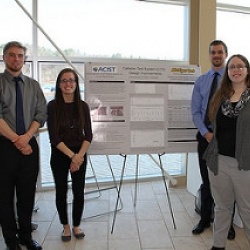
Catheter Test System Design Improvements
Team Members: Cameron Allen, Kaitlyn Boelter, Mitchell Kirby, Kimberly Stanke, and Jonathon Wheatley,
Biomedical Engineering
Advisor: Sean Kirkpatrick, Biomedical Engineering
Sponsor: ACIST Medical Systems
Project Overview:
The Navvus MicroCatheter from ACIST Medical, currently in clinical use, allows for
a real time fractional flow reserve (FFR) measurement using a fiber optic sensing
technique. The FFR is a diagnostic value that quantitatively shows blockage of an
artery by measuring blood pressure on either side of the blockage. This Navvus MicroCatheter
arrives pre-calibrated and is capable of giving more accurate measurements than traditional
pressure wires. The current state-of-the-device calibration methods are slow and costly.
Calibration accounts for a large percentage of production time, more than manufacturing
the device itself. The goal of this project is to develop a more efficient way to
calibrate the device to optimize production and distribution.
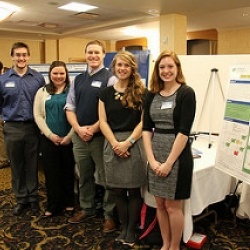
Compliance Keweenaw: Aspirus Keweenaw Hand-washing Compliance System
Team Members: Anna Waller, Jannah Brandt, Drew Markel, Creighton Bradley, and Rebecca Manshaem,
Biomedical Engineering
Advisor: Bruce Lee, Biomedical Engineering
Sponsor: Aspirus Keweenaw
Project Overview:
Hand hygiene is of importance to hospitals not only for the safety and health of employees
but also to reduce the spread of hospital-acquired infections and protect patients.
Aspirus Keweenaw recruited our team to create an automated system to track hand-washing
compliance among employees to assist them in their goal of 100 percent compliance.
We created a system using a microcontroller and RFID readers to detect when a healthcare
worker enters a patient’s room and reaches compliance using the sanitizing foam dispenser.
This system will be placed near the doorway and communicate with a wristband that
identifies the healthcare worker and vibrates as a reminder if compliance is not reached.
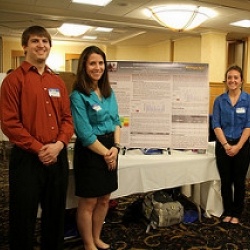
Leadless Pacemaker Fixation System
Team Members: Mareah Meulemans, Arick Lagowski, Brent Myers, Elyssa Furmanski and Tiffany Moore,
Biomedical Engineering
Advisor: Rupak Rajachar, Biomedical Engineering
Sponsor: Medtronic
Project Overview:
The primary complications with pacemakers include lead dislodgements, pneumothorax
from
vein access, pocket hematomas and pocket infections. Over the past few years, Medtronic
has created a pacemaker that is implanted directly in the right ventricle which benefits
patients who need only pacing. However, for patients with heart failure, pacing the
left side of the heart is more advantageous. The goal of this project is to design
a fixation system that can attach a 1 cc rectangular pacemaker to the heart. The fixation
must be able to be repositioned and it must be delivered at a distance via a small
tube. The delivery tool needs to be considered but not the main objective.
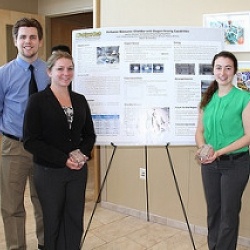
Perfusion Bioreactor Chamber with Oxygen Sensing Capabilities
Team Members: Rebecca Whitney, Benjamin Weyland, and Jessica Walitalo, Biomedical Engineering;
Kimberly D’Augustino, Materials Science and Engineering
Advisor: Feng Zhao, Biomedical Engineering
Sponsor: Michigan Technological University
Project Overview
Perfusion Bioreactors are commonly used for 3D construct development in tissue engineering;
however, there is currently not a system on the market that allows for the measurement
of oxygen concentration in the tissue medium. Oxygen is a key regulator of cell survival
and phenotypic expression. The challenge presented to our team was to design and develop
a perfusion bioreactor chamber with oxygen sensing capability without location and
time constraints.
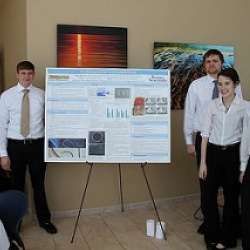
Pro-Healing Arterial Graft Scaffold Design
Team Members: Thomas Brown, Kristin Flickinger, Thaine Fuller, Kyle Jansen, and Daniel Radke, Biomedical
Engineering
Advisor: Jeremy Goldman, Biomedical Engineering
Sponsor: Boston Scientific
Project Overview:
Inflammation, thrombosis, and restenosis of the implanted section are the major challenges
that impede the work being done to reconstruct small diameter arteries. The aim of
this project is to optimize the construction of a small-diameter vascular graft that
utilizes the biological tissue, elastic lamina, coated in a polymer coating for mechanical
strength. The main goal for the optimization of the fabrication process is to reduce
and ultimately eliminate the delamination of the polymer and the elastic lamina and
the negative host response that was found in a previous project. The efficacy of the
resulting grafts will be tested for mechanical integrity and biological viability
(in vivo rat model).
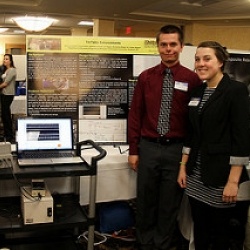
Tilt Test Enhancements
Team Members: Samantha Wright, Michael Briseno, Christopher Fisher, Jari Sague, and Jasmine Jauquet,
Biomedical Engineering
Advisor: Orhan Soykan, Biomedical Engineering
Sponsor: Aspirus Heart and Vascular
Project Overview:
In order to improve current tilt testing data acquisition, Aspirus Heart and Vascular
requests an integrated continuous monitoring technology and software display. The
current procedure is either too slow or too invasive, and there is no good method
for data storage and analysis. In response to this, we created a program that will
generate and display relative data, which will allow for simple differentiation between
various cardiovascular states. To achieve this, we used LabVIEW as the software platform
and integrated it with a continuous blood pressure monitoring device, ECG, and goniometer
to display the data in a form that the physician can view and manipulate as needed.
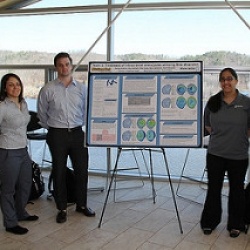
Treatment of Intra-Cranial Aneurysms Utilizing Flow Diversion
Team Members: Kathleen Ikeda, Alexandria Bartlett, Alexis Alvarez, Mark Keranen, and Kyle Johnston,
Biomedical Engineering
Advisor: Jingfeng Jiang, Biomedical Engineering
Sponsor: Materialise
Project Overview:
The concept of flow diversion has become a popular treatment option for intra-cranial
aneurysms. Our team is using the concept of flow-diversion to explore a novel design
approach through virtual prototyping and the use of a physical flow phantom. The design
is intended to reduce the flow into the aneurysm, help in clot formation inside the
aneurysm, and allow healing. This design presents an advantage over flow-diverting
stents by not causing a disruption of the sensitive tissue that surrounds the neck
of the aneurysm. The team uses computational fluid dynamics (CFD), finite element
modeling (FEM), and technology provided by Materialise to simulate device performance
after implementation into patient-specific data.
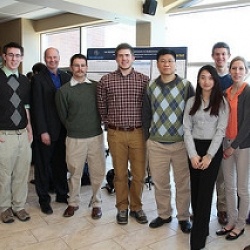
User Interface Design for Deep Brain Stimulation Implants in Parkinson’s Patients
Team Members: Hao Zhan, Jessica Thomeke, Keegan Yates, Hunter Bartosik, Joseph Bolsenga, and Timothy
Bradt, Computer Engineering
Advisor: Keat Ghee Ong, Biomedical Engineering
Sponsor: Medtronic
Project Overview
Parkinson’s disease (PD) patients with deep brain stimulation (DBS) implanted devices
are typically provided with a means of controlling their device. In some cases, conventional
touch screen interfaces are unsuitable or difficult to use. This project looked to
determine what guidelines and features are desirable for designing a user interface
for the DBS controller for PD patients. The general topic is broad because there are
no existing guidelines to design user interfaces for this particular patient population.
Thus, three main ideas were chosen to study through clinical trials including the
size of elements in the user interface, the comparison between three control models,
and general preferences for using a user interface.
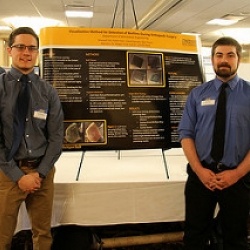
Visualization of Biofilms on Orthopedic Implants
Team Members: Kaleb Horn, Kyle Troutt, David Sproule, and Maxwell Hill, Biomedical Engineering
Advisor: Megan Frost, Biomedical Engineering
Sponsor: Department of Biomedical Engineering
Project Overview:
The number of infections on orthopedic implants is increasing as the number of hip
and knee replacements required also increases in an aging population. Treatment of
these infections requires a lengthy and significantly invasive surgery. Our objective
is to develop a quick, reliable and repeatable method to aid in the visualization
of biofilms during a surgery. As the surgeon is cleaning the implant to eliminate
infection, it is important to use minimal manpower, nontoxic chemicals, and ensure
an absence of false negatives. All equipment used must be as small as possible to
prevent hindrance of the surgical team.